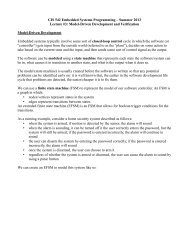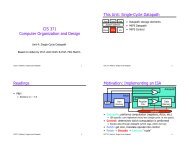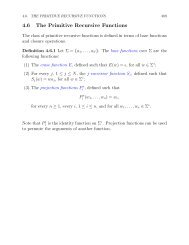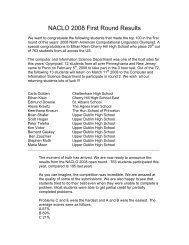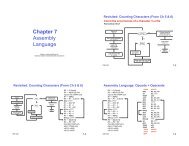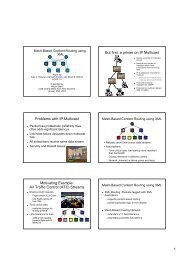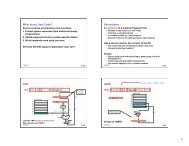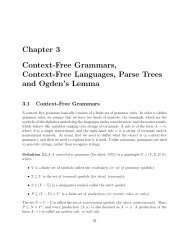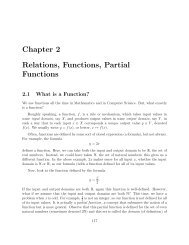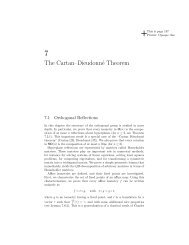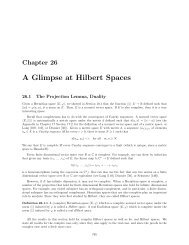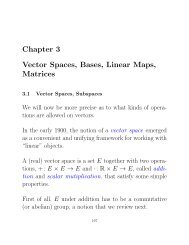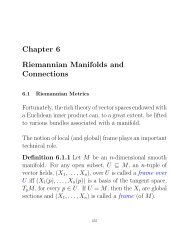CobotDS: A Spoken Dialogue System for Chat - Computer ...
CobotDS: A Spoken Dialogue System for Chat - Computer ...
CobotDS: A Spoken Dialogue System for Chat - Computer ...
Create successful ePaper yourself
Turn your PDF publications into a flip-book with our unique Google optimized e-Paper software.
<strong>CobotDS</strong>: A <strong>Spoken</strong> <strong>Dialogue</strong> <strong>System</strong> <strong>for</strong> <strong>Chat</strong><br />
Michael KearnsÝ, Charles IsbellÞ, Satinder SinghÜ, DianeLitmanß, Jessica Howe<br />
ÝDepartment of <strong>Computer</strong> and In<strong>for</strong>mation Science, University of Pennsylvania, mkearns@cis.upenn.edu<br />
ÞCollege of Computing, Georgia Institute of Technology, isbell@cc.gatech.edu<br />
ÜSyntek Capital, baveja@cs.colorado.edu<br />
ß<strong>Computer</strong> Science Department and LRDC, University of Pittsburgh, litman@cs.pitt.edu<br />
Laboratory <strong>for</strong> Artificial Intelligence, Massachussetts Institute of Technology, howej@ai.mit.edu<br />
Abstract<br />
We describe <strong>CobotDS</strong>, a spoken dialogue system providing<br />
access to a well-known internet chat server called LambdaMOO.<br />
<strong>CobotDS</strong> provides real-time, two-way, natural language<br />
communication between a phone user and the multiple<br />
users in the text environment. We describe a number of the<br />
challenging design issues we faced, and our use of summarization,<br />
social filtering and personalized grammars in tackling<br />
them. We report a number of empirical findings from a<br />
small user study.<br />
Introduction<br />
We describe the design, implementation and empirical experiences<br />
of <strong>CobotDS</strong> (<strong>for</strong> Cobot <strong>Dialogue</strong> <strong>System</strong>). <strong>CobotDS</strong><br />
extends our ongoing work on Cobot (Isbell et al. 2000;<br />
2001), a software agent that resides in a well-known,<br />
text-based internet chat environment called LambdaMOO.<br />
Founded in 1990, LambdaMOO (Cherny 1999; Foner 1997)<br />
is frequented by hundreds of users who converse with each<br />
other using both natural language text and verbs <strong>for</strong> expressing<br />
(in text) common real-world gestures (such as laughing,<br />
hugging, nodding and many others). 1 Cobot is one of the<br />
most popular LambdaMOO residents, and both chats with<br />
human users, and provides them with “social statistics” summarizing<br />
their usage of verbs and interactions with other<br />
users (such as who they interact with, who are the most<br />
“popular” users, and so on).<br />
<strong>CobotDS</strong> provides LambdaMOO users with spoken telephony<br />
access to Cobot, and is an experiment in providing<br />
a rich social connection between a telephone user and the<br />
text-based LambdaMOO users. To support conversation,<br />
<strong>CobotDS</strong> passes messages and verbs from the phone user<br />
to LambdaMOO users (via automatic speech recognition, or<br />
ASR), and from LambdaMOO to the phone user (via text-tospeech,<br />
or TTS). <strong>CobotDS</strong> also provides “listening” (allowing<br />
phone users to hear a description of all LambdaMOO activity),<br />
chat summarization and filtering, personalized grammars,<br />
and many other features.<br />
Copyright c 2002, American Association <strong>for</strong> Artificial Intelligence<br />
(www.aaai.org). All rights reserved.<br />
1 Lines L1 and L14 in Table 1 illustrate the use of chat and verbs<br />
in LambdaMOO, respectively, and will be explained in detail below.<br />
Our goal in building <strong>CobotDS</strong> was twofold. First, many<br />
LambdaMOO users log on as a <strong>for</strong>m of regular social activity<br />
with a collection of friends and acquaintances. As a<br />
practical matter, we hope that <strong>CobotDS</strong> may provide an alternate<br />
means of access to LambdaMOO—either out of necessity<br />
(such as when a user is unable to access the internet),<br />
out of a desire to use a different input modality (speech<br />
instead of typing), or as an entertaining accompaniment to<br />
logging on directly. Second, we find it interesting to build<br />
a system that deliberately <strong>for</strong>ms a connection, and blurs the<br />
distinction, between a world typically thought of as “real”<br />
(the world of telephones) and one typically thought of as<br />
“virtual”. We also believe our experiences may hold lessons<br />
<strong>for</strong> future attempts to provide spoken access to text systems<br />
(such as instant messaging), and more generally <strong>for</strong> multimodal<br />
systems.<br />
Traditional dialogue systems are designed to provide access<br />
to a relatively structured and static back-end database<br />
(such as airline reservation in<strong>for</strong>mation), where users have<br />
well-defined, task-oriented goals (DARPA 2001; Sidner<br />
2000). Compared to such systems, <strong>CobotDS</strong> is novel in a<br />
number of ways, and raises interesting challenges <strong>for</strong> dialogue<br />
system design.<br />
First, <strong>CobotDS</strong> is one of the first dialogue systems to provide<br />
speech access to a complex social environment, where<br />
users participate primarily <strong>for</strong> entertainment or a sense of<br />
community. As such, it is difficult to anticipate user expectations<br />
or desires <strong>for</strong> <strong>CobotDS</strong>. For example, it was unclear<br />
whether users would prefer to use <strong>CobotDS</strong> <strong>for</strong> interaction<br />
with their LambdaMOO friends, or more as a passive listening<br />
mechanism. It was also unclear whether users would<br />
use the system primarily <strong>for</strong> LambdaMOO access when they<br />
were unable to log in to the text environment directly, or as<br />
an accompaniment to online access. Our approach to these<br />
questions is to try to provide enough functionality to shed<br />
some light on user needs, rather than fixing a model of them<br />
in advance. Thus, <strong>CobotDS</strong> should be viewed as an exploratory<br />
and evolving system.<br />
Second, the “database” accessed by <strong>CobotDS</strong> is a dynamic<br />
and unstructured stream of natural language text, verb<br />
exchanges, and other actions. Conversational topics are interleaved,<br />
and users enter and exit at will. Providing the<br />
phone user with a useful view of this activity, as well as sufficiently<br />
rich means of participating in it, is a demanding
Human<br />
LambdaMOO<br />
users<br />
00000 11111<br />
00000 11111 01<br />
01<br />
00000 11111 01<br />
01<br />
01<br />
01<br />
01<br />
01<br />
01<br />
01<br />
000000<br />
111111 01<br />
01<br />
000000<br />
111111 01<br />
01<br />
000000<br />
111111 01<br />
01<br />
000000<br />
111111 01<br />
01<br />
01<br />
01<br />
01<br />
01<br />
01<br />
01<br />
01<br />
01<br />
00000 11111 01<br />
01<br />
00000 11111 01<br />
01<br />
00000 11111 01<br />
01<br />
00000 11111 01<br />
01<br />
00000 11111 01<br />
01<br />
00000 11111 01<br />
01<br />
00000 11111 01<br />
01<br />
00000 11111 01<br />
01<br />
00000 11111 01<br />
01<br />
telnet<br />
telnet<br />
Cobot<br />
telnet<br />
event queue<br />
00000 11111<br />
00000 11111 01<br />
01<br />
00000 11111 01<br />
01<br />
01<br />
01<br />
01<br />
01<br />
01<br />
01<br />
000000<br />
111111 01<br />
01<br />
000000<br />
111111 01<br />
01<br />
000000<br />
111111 01<br />
01<br />
000000<br />
111111 01<br />
01<br />
01<br />
01<br />
01<br />
01<br />
01<br />
01<br />
01<br />
01<br />
00000 11111 01<br />
01<br />
00000 11111 01<br />
01<br />
00000 11111 01<br />
01<br />
00000 11111 01<br />
01<br />
00000 11111 01<br />
01<br />
00000 11111 01<br />
01<br />
00000 11111 01<br />
01<br />
00000 11111 01<br />
01<br />
00000 11111 01<br />
01<br />
LambdaMOO<br />
server<br />
<strong>CobotDS</strong><br />
ASR TTS<br />
phone<br />
user<br />
Figure 1: Architectural sketch of <strong>CobotDS</strong>, Cobot, and LambdaMOO,<br />
providing two-way communication between phone and<br />
chat users.<br />
design problem. Some of the methods we applied and will<br />
discuss include summarization and filtering (to reduce the<br />
load on the phone user during busy times), and the use of<br />
“personal” grammars (to provide phone users with a rich set<br />
of personalized utterances within the current limitations of<br />
ASR).<br />
Third, there are many issues of imbalance and asynchrony<br />
between the <strong>CobotDS</strong> phone user and the LambdaMOO text<br />
users. The phone user has a limited channel to LambdaMOO<br />
(due to the imperfections of ASR), and a potentially rich and<br />
cognitively challenging channel from LambdaMOO (as the<br />
phone user must absorb the action in real time via TTS, and<br />
does not have text-based scroll back capabilities). We have<br />
taken first steps in bridging this gap, and dealing with its<br />
consequences—such as time lag—but clearly more research<br />
is needed.<br />
In the remainder of this paper, we sketch some salient<br />
points about the system architecture, provide an overview<br />
of the functionality provided by <strong>CobotDS</strong> to both phone and<br />
LambdaMOO users, and report on a number of interesting<br />
empirical findings derived from a small user study.<br />
<strong>CobotDS</strong> Architecture<br />
Cobot connects to the LambdaMOO server as a client, just<br />
as any human user would, and maintains in<strong>for</strong>mation about<br />
LambdaMOO that he uses <strong>for</strong> his chat interactions and social<br />
statistics services. Although <strong>CobotDS</strong> and Cobot appear<br />
to users as a single system, in reality <strong>CobotDS</strong> is implemented<br />
as a separate set of processes handling ASR, TTS,<br />
telephony, dialogue management, and semantic processing,<br />
built using a general purpose plat<strong>for</strong>m <strong>for</strong> spoken dialogue<br />
systems (Levin et al. 1999). Thus, Cobot interacts with<br />
LambdaMOO and its users, while <strong>CobotDS</strong> interacts with<br />
the phone user. Figure 1 provides a sketch of the overall<br />
architecture.<br />
LambdaMOO events or messages to be communicated<br />
from Cobot to <strong>CobotDS</strong> (and thus to the phone user) are handled<br />
by an event queue lying between Cobot and <strong>CobotDS</strong>.<br />
As such events occur, Cobot places them in the event queue,<br />
which <strong>CobotDS</strong> flushes at each dialogue turn. The event<br />
queue is a buffering mechanism designed to address the fact<br />
that the rate at which events can be pushed to the phone user<br />
may sometimes lag considerably behind the rate at which<br />
they are being generated in LambdaMOO. The desire to<br />
minimize this lag led to our implementation of some interesting<br />
queue filtering mechanisms (discussed later).<br />
In the other direction, events to be passed from the phone<br />
user to LambdaMOO are immediately passed from <strong>CobotDS</strong><br />
to Cobot. No explicit queuing mechanism is necessary. As<br />
Cobot notices messages from the phone user he processes<br />
them, just as he processes events from LambdaMOO as they<br />
occur. <strong>CobotDS</strong> Functionality Overview<br />
Table 1 is a sample dialogue illustrating all of the commands<br />
provided by <strong>CobotDS</strong> to both the phone and LambdaMOO<br />
users, and will be used extensively <strong>for</strong> expository purposes.<br />
Although hypothetical, the dialogue is representative of the<br />
actual dialogues discussed in the section on empirical findings,<br />
and all of the functionality shown is implemented.<br />
After a brief login procedure (turns C1 and C2 of Table<br />
1) 2 , the phone user is placed in the main command loop,<br />
where he is repeatedly prompted <strong>for</strong> a <strong>CobotDS</strong> command<br />
(as in line C3S). User response is interpreted through ASR,<br />
and the resulting command executed. For example, after<br />
C3U, on the phone side, <strong>CobotDS</strong> tells the phone user what<br />
was heard, executes the command, and passes any messages<br />
or verbs directed towards them (via Cobot) from LambdaMOO<br />
users (line C4S). In LambdaMOO, completion of<br />
the <strong>CobotDS</strong> user login causes Cobot to announce the call<br />
in LambdaMOO (lines L3-L4).<br />
Communicating with the Phone User<br />
LambdaMOO users can pass messages to the phone user by<br />
directing a text message beginning with phone: to Cobot, as<br />
on line L7. If the text following phone: can be interpreted<br />
as a common LambdaMOO verb (line L11), it is passed on<br />
as such to the phone user via TTS (line C9S); otherwise, it<br />
is treated as an act of directed speech (lines L7 and C6S).<br />
In either case, the LambdaMOO user invoking phone: on<br />
Cobot is credited with the action.<br />
Basic LambdaMOO Verbs<br />
We now move on to discuss the commands provided to the<br />
phone user that can be invoked after prompting in the main<br />
command loop. The most basic functionality is the replication<br />
of the most common LambdaMOO verbs, such as<br />
waving and hugging (currently <strong>CobotDS</strong> supports 38 such<br />
verbs). These verbs can be invoked either without or with<br />
a user name (lines C4U and C6U, respectively), generating<br />
different behaviors by Cobot in LambdaMOO (lines L5 and<br />
L9-L10, respectively). Note that LambdaMOO users are already<br />
accustomed to using the same simple syntax <strong>for</strong> these<br />
verbs.<br />
Conversation and Grammars<br />
Despite the importance of verb use, LambdaMOO remains<br />
primarily a chat environment. To the extent possible, we felt<br />
2 To control system access and load, only a limited set of users<br />
have been granted <strong>CobotDS</strong> passwords. There are currently 33,<br />
including the authors.
<strong>CobotDS</strong> Transcript<br />
(spoken; phone user and <strong>CobotDS</strong> alternate)<br />
C1S. Hello, who is this? (<strong>CobotDS</strong> prompt)<br />
C1U. Buster. (phone user response)<br />
C2S. Secret password?<br />
C2U. Eight three two two. [C(a), successful login]<br />
C3S. Hi, Buster. What do you want to do?<br />
C3U. Who.<br />
C4S. You who. I am with Cocobot, Betwixt, and HFh.<br />
C4U. Wave. [C(b)]<br />
C5S. You wave.<br />
C5U. Where.<br />
C6S. You where. I am in The Cobotatory. HFh says How was the<br />
movie?, to you. [L(a)]<br />
C6U. Smile Betwixt. [C(c)]<br />
C7S. You smile to Betwixt.<br />
C7U. Say HFh.<br />
C8S. What message would you like to pass?<br />
C8U. Fantastic. [C(d), smalltalk ASR grammar]<br />
C9S. You say Fantastic, to HFh. Betwixt waves to you. [L(b)]<br />
C9U. Say.<br />
C10S. What message would you like to pass?<br />
C10U. What’s going on in the MOO?. [C(e), smalltalk ASR grammar]<br />
C11S. You say What’s going on in the MOO, to everyone.<br />
C11U. Summarize.<br />
C12S. You summarize. Recently, HFh and Betwixt chatted. Betwixt<br />
and GreenBean bickered. HFh and Natto had a friendly conversation.<br />
I added to the noise. HFh made the most noise.<br />
C12U. Grammar (ASR rejects the utterance, and returns nothing).<br />
C13S. Next. HFh says I am providing hoops wisdom to Betwixt,<br />
to you, and then, Betwixt says, HFh is pontificating on the Knicks<br />
again. Where are you?, to you. [L(c),L(d)]<br />
C13U. Grammar.<br />
C14S. Which grammar would you like to use? The choices are<br />
smalltalk, personal, and cliche.<br />
C14U. Personal.<br />
C15S. The grammar is now set to Buster.<br />
C15U. Say Betwixt.<br />
C16S. What message would you like to pass?<br />
C16U. I am in Hoboken. [C(f), Buster personal grammar]<br />
c17S. You say I am in Hoboken, to Betwixt.<br />
C17U. Listen. [C(g), listen mode turned on]<br />
C18S. You listen. Betwixt gives you a nod. HFh to Betwixt,<br />
Sprewell can always be counted on to go straight to the rim, but<br />
Houston settles <strong>for</strong> jumpers from the parking lot, and then, I grin<br />
to HFh. [L(e),L(f),L(g)]<br />
C18U. Grin HFh. [C(h)]<br />
C19S. You grin to HFh. Betwixt to HFh, With Camby’s rebounding<br />
they have a chance to at least win the East, and then, HFh to<br />
Betwixt, Ummm, as long as he doesn’t send his coach to intensive<br />
care first, and then, Natto teleports in from the Living Room, and<br />
then, Betwixt to HFh, Good point. [L(h),L(i),L(j),L(k)]<br />
LambdaMOO Transcript<br />
(text, joined in progress; multiple users and Cobot in<br />
ongoing, interleaved dialogues)<br />
L1. HFh [to Betwixt]: And thanks to TiVo, I was able to see<br />
the game when I got home.<br />
L2. Betwixt [to HFh]: I missed the first half because I was<br />
busy shoveling our record snowfall. But the second half was<br />
pretty spectacular.<br />
L3. Cobot turns to pick up the phone. [C(a)]<br />
L4. Cobot begins talking to Buster! [C(a)]<br />
L5. Cobot holds up a sign: Buster passes on a wave from the<br />
phone. [C(b)]<br />
L6. HFh pats Cobot on the head.<br />
L7. HFh [to Cobot]: phone: How was the movie? [L(a)]<br />
L8. Betwixt [to HFh]: Overall, it’s one of their better<br />
stretches this year.<br />
L9. Cobot smiles at Betwixt. [C(c)]<br />
L10. Cobot [to Betwixt]: That was from Buster. [C(c)]<br />
L11. Betwixt [to Cobot]: phone: wave [L(b)]<br />
L12. Cobot [to HFh]: Fantastic [C(d)]<br />
L13. Cobot [to HFh]: That was from Buster. [C(d)]<br />
L14. HFh nods to Betwixt.<br />
L15. HFh [to Betwixt]: But it can’t last. The soap opera<br />
always takes over at some point. Drama over basketball.<br />
L16. Cobot holds up a sign: Buster says, ’What’s going on<br />
in the MOO’ from the phone. [C(e)]<br />
L17. HFh [to Cobot]: phone: I am providing hoops wisdom<br />
to Betwixt. [L(c)]<br />
L18. Betwixt [to Cobot]: phone: HFh is pontificating on the<br />
Knicks again. Where are you? [L(d)]<br />
L19. Betwixt [to HFh]: Your problem is you have no faith.<br />
L20. HFh [to Betwixt]: Yours is that you have too much in<br />
the wrong team.<br />
L21. HFh cackles madly at Betwixt!<br />
L22. Cobot holds up a sign: Buster says, ’I am in Hoboken’<br />
from the phone. [C(f)]<br />
L23. Betwixt [to Cobot]: phone: nod [L(e)]<br />
L24. Cobot holds up a sign: Buster passes on a listen from<br />
the phone. [C(g)]<br />
L25. HFh [to Betwixt]: Sprewell can always be counted on<br />
to go straight to the rim, but Houston settles <strong>for</strong> jumpers from<br />
the parking lot. [L(f)]<br />
L26. Cobot [to HFh]: This is from Buster: [C(h),L(g)]<br />
L27. Cobot grins at HFh. [C(h),L(g)]<br />
L28. Betwixt [to HFh]: With Camby’s rebounding they have<br />
a chance to at least win the East. [L(h)]<br />
L29. HFh [to Betwixt]: Ummm, as long as he doesn’t send<br />
his coach to intensive care first. [L(i)]<br />
L30. Natto teleports in from the Living Room. [L(j)]<br />
L31. Betwixt [to HFh]: Good point [L(k)].<br />
Table 1: Parallel <strong>CobotDS</strong>-LambdaMOO transcripts <strong>for</strong> a sample dialogue. The left-hand column shows a dialogue with <strong>CobotDS</strong>, with the<br />
th dialogue turn numbered CS (system) and CU (user). The right-hand side shows the activity taking place in LambdaMOO during this call,<br />
with the th event numbered L. Events in <strong>CobotDS</strong> that cause announcements in LamdbaMOO are labeled as [C(x)] on the left-hand side,<br />
with the same label marking the resulting announcements on the right-hand side. Similarly, events in LambdaMOO that cause announcements<br />
in <strong>CobotDS</strong> are labeled as [L(x)] on the right-hand side, with the same label marking the resulting announcements on the left-hand side.
it important to provide some reasonably expressive mechanisms<br />
<strong>for</strong> conversational exchange. It is rather easy to provide<br />
unconstrained message-passing from LambdaMOO to<br />
the phone user; however, communication from the phone<br />
user to LambdaMOO is severely hampered by the limitations<br />
of ASR. Nonetheless, <strong>CobotDS</strong> provides a say command<br />
(that takes an optional user name argument). Upon<br />
invoking the say command (as in line C7U), the phone user<br />
enters a one-step sub dialogue where he is prompted <strong>for</strong> the<br />
utterance he wishes to pass (turn C8). This utterance is then<br />
given to ASR, along with the recognition grammar that is<br />
currently in effect. Be<strong>for</strong>e passing the output of ASR on to<br />
LambdaMOO, <strong>CobotDS</strong> per<strong>for</strong>ms a backmatching step: the<br />
ASR output phrase is matched against each of the phrases in<br />
the current recognition grammar, and the phrase most similar<br />
to the ASR phrase is then passed on to LambdaMOO<br />
(lines L12-L13). 3<br />
<strong>CobotDS</strong> has two built-in grammars, the smalltalk and<br />
cliche grammars, and a personal grammar that differs <strong>for</strong><br />
each phone user. The smalltalk grammar consists of 228<br />
hand-constructed phrases providing basic conversational<br />
queries, responses, and remarks. (Examples include variants<br />
of “yes” and “no”; locational assertions such as “I<br />
am at home”; exclamations like “fantastic” or “terrible”;<br />
LambdaMOO-specific phrases such as “What’s going on in<br />
the MOO?” and “My connection is down”; and conversational<br />
staples such as “How are you” and “I am fine”.) The<br />
cliche grammar consists of 2950 common English sayings<br />
(such as “It takes one to know one” and “A rose by any other<br />
name would smell as sweet”). The personal grammar consists<br />
of a list of phrases provided by each phone user. The<br />
smalltalk grammar is initially in effect. The phone user can<br />
change the grammar by using the grammar command (line<br />
C13U), initiating a one-step sub dialogue where the phone<br />
user is prompted <strong>for</strong> a grammar name (turn C14). 4<br />
The hope is that the smalltalk grammar provides the rudiments<br />
of conversation, the cliche grammar contains common<br />
witticisms allowing the phone user to occasionally make an<br />
appropriate remark on LambdaMOO action, and the personal<br />
grammar can be used <strong>for</strong> the favorite phrases of the<br />
user. The use of multiple grammars <strong>for</strong> the say command,<br />
and allowing users to construct grammars, are potentially interesting<br />
experiments in placing users in more direct control<br />
of technology.<br />
Listening and Social Filtering<br />
In addition to allowing the phone user to send and receive<br />
messages, we anticipate that phone users may sometimes<br />
wish to hear all the action in LambdaMOO. Indeed, it is possible<br />
that some phone users may primarily use <strong>CobotDS</strong> as<br />
a passive source of entertainment (somewhat like listening<br />
to a radio talk show), interacting only minimally. The listen<br />
3 Here, the similarity of two phrases is determined by treating<br />
each as a vector of word counts and computing the normalized inner<br />
product between them. This is a common and well-understood<br />
technique from in<strong>for</strong>mation retrieval.<br />
4 The user only has to say “personal”, because his identity, and<br />
thus the grammar to load, is known from the login process.<br />
1<br />
0.9<br />
0.8<br />
0.7<br />
0.6<br />
0.5<br />
0.4<br />
0.3<br />
0.2<br />
0.1<br />
% of time all words spoken<br />
Average % of words spoken when some dropped<br />
0<br />
10 15 20 25 30 35 40 45 50 55 60<br />
Amount of wait time be<strong>for</strong>e an event is heard by phone user (seconds)<br />
Figure 2: In<strong>for</strong>mation loss due to filtering, computed from LambdaMOO<br />
event logs. The x-axis shows the maximum number of<br />
seconds allotted between the time an event occurs in LambdaMOO<br />
and the time its filtered version is read to the phone user. (This<br />
interval includes the overhead time required to record the phone<br />
user’s command, about 7 seconds.) For the solid line, the y-axis<br />
shows the fraction of turns <strong>for</strong> which no filtering of events was<br />
necessary (because in the allotted time, it was possible to read out<br />
completely the events generated in the last dialogue turn). For the<br />
dashed line, the y-axis shows the ratio of the length of the filtered<br />
text to the length of the original whenever filtering had to be used.<br />
This graph was computed from several days of LambdaMOO activity;<br />
nearly identical plots were obtained <strong>for</strong> other time periods.<br />
Note that increasing the allowed lag beyond 20-25 seconds (corresponding<br />
to about 59 words) does not significantly increase the<br />
overall in<strong>for</strong>mation reaching the phone user.<br />
command (line C17U) puts <strong>CobotDS</strong> into a special mode<br />
where every system prompt in the main command loop includes<br />
a filtered version of all the activity taking place in<br />
LambdaMOO during the last dialogue turn (lines C18S and<br />
C19S). This mode is turned off by invoking the mute command.<br />
One difficulty that arises in implementing listen is the empirical<br />
fact that the rate at which TTS can read text can lag<br />
considerably behind the rate at which text is being generated<br />
in LambdaMOO. Our solution is to fix the length of the<br />
text that will be read with each prompt (independent of how<br />
much activity took place), but to use this text to summarize<br />
all activity since the last turn; hence the need <strong>for</strong> a filtering<br />
mechanism.<br />
A trade-off arises in choosing the length of the text to be<br />
read: a shorter length results in lower maximum time lag <strong>for</strong><br />
the phone user, but <strong>for</strong>ces more severe filtering. We empirically<br />
determined that a length of 59 words strikes a good<br />
balance (see Figure 2). We also decided to personalize the<br />
filtering <strong>for</strong> each user based on their past social interactions<br />
in the text environment, as observed by Cobot. There is an<br />
ordered set of filtering rules, and each rule is applied in turn<br />
until the desired length is met. While the earliest of these<br />
rules is not personalized, eventually all the activity generated<br />
by users with whom the phone user has little or no past
interaction may be dropped from the summary.<br />
Special In<strong>for</strong>mational Commands<br />
Finally, <strong>CobotDS</strong> provides commands giving in<strong>for</strong>mation on<br />
the current state of the text environment (which generate responses<br />
to phone users but not to LambdaMOO users). The<br />
where and who commands (lines C5U and C3U) tell the<br />
phone user which room of LambdaMOO Cobot currently<br />
occupies 5 (line C6S), and which LambdaMOO users are<br />
present there (line C4S), respectively.<br />
More interesting is the summarize command (line<br />
C11U), which presents the phone user with a coarse summary<br />
of the last 10 minutes of activity in LambdaMOO (or<br />
the last Ò minutes, if the phone user utters an integer argument).<br />
Cobot uses his social statistics to compute which<br />
users have generated the most activity (in terms of number<br />
of verb invocations), which pairs of users have interacted<br />
the most, and which players have entered and exited (as in<br />
line C12S). The pairwise interactions may be characterized<br />
as “friendly” (if the fraction of verbs such as smile exceeds<br />
a certain threshold), or “nasty” (if the fraction of verbs such<br />
as kick exceeds a threshold).<br />
The motivation behind summarize is to allow the phone<br />
user, either upon login or later in the dialogue, to get a brief<br />
synopsis of who is present and the nature of their interactions,<br />
if any. We view the command as a “batch” operation<br />
crudely summarizing a long time period. By contrast, the filtering<br />
mechanism used by the listen command gives a “play<br />
by play” synopsis of the action, and is designed <strong>for</strong> real-time<br />
summarization.<br />
Empirical Findings<br />
As of this writing, over 300 calls have been placed to<br />
<strong>CobotDS</strong>. Excluding the authors, 18 users have placed at<br />
least one call to the system. <strong>CobotDS</strong> is thus an active service<br />
provided to select LambdaMOO users, and a wide variety<br />
of experiences and usage patterns have been reported to<br />
and observed by us.<br />
To quantify the empirical use of <strong>CobotDS</strong> in a more controlled<br />
manner, we conducted a small and in<strong>for</strong>mal user<br />
study during a recent two-week period. We restricted our<br />
attention to five (non-author) users who made at least 5 calls<br />
each to <strong>CobotDS</strong> during the study period (two females, three<br />
males, all native speakers). This section describes a number<br />
of quantitative and anecdotal findings derived from our complete<br />
logs (on both the <strong>CobotDS</strong> and LambdaMOO sides)<br />
of the calls made by this restricted user group, as well as<br />
from the personal grammars submitted by the users. Note,<br />
however, that the logs represent <strong>CobotDS</strong>’s (post-ASR) interpretation<br />
of the user’s utterances, and are thus only an<br />
approximation of the phone user’s true intent.<br />
Some of our findings are given in Table 2. Each column<br />
represents a user, and the rows show <strong>CobotDS</strong> or LambdaMOO<br />
usage statistics <strong>for</strong> that user. Note that there are<br />
5 LambdaMOO actually consists of multiple distinct chat<br />
rooms, connected by virtual exits and entrances that are navigable<br />
by standard system commands. Cobot divides his time between<br />
two different LambdaMOO rooms.<br />
many differences between users. For example, the average<br />
number of dialogue turns per call (row 2) varies from <br />
<strong>for</strong> Benny to <strong>for</strong> Nisa. This latter figure corresponds<br />
to an average call duration of over 20 minutes, suggesting<br />
that <strong>CobotDS</strong> is being used <strong>for</strong> extended social interaction<br />
by some users.<br />
This view is supported by other figures in the table. Consider<br />
turns where (<strong>CobotDS</strong> believes that) the phone user<br />
executed an interaction command (either say or any LambdaMOO<br />
verb), affecting both the phone and LambdaMOO<br />
users. The fraction of interaction commands (row 4) across<br />
all users is 0.50 (ranging from Etoile’s 0.33 to Huey’s 0.59).<br />
Among the interaction turns, users vary in their use of say<br />
versus other verbs (row 5). Etoile is relatively verbal (at<br />
0.83), while Huey is relatively gestural (at 0.38).<br />
Users often provided username arguments <strong>for</strong> interaction<br />
commands (directed interaction, rows 6 and 7), and tended<br />
to interact with multiple LambdaMOO users (rows 8 and 9).<br />
Interestingly, the LambdaMOO users communicating with<br />
the phone user tended to use say more frequently (about<br />
79 percent of the time) than the verbs (row 11). This is in<br />
contrast with the usage of say between LambdaMOO users<br />
(roughly 43 percent).<br />
The listen command was also reasonably popular, with<br />
an average of 0.61 invocations per dialogue across all users<br />
(row 12). Some users enter listen mode and stay there <strong>for</strong><br />
considerable periods of time (row 14, particularly Huey), but<br />
users also tend to turn listen mode on only later in the dialogue<br />
(row 15, where we see that listen mode is first invoked<br />
after 38 turns on average). This is consistent with our in<strong>for</strong>mal<br />
observation that there is typically a flurry of interaction<br />
between the phone and LambdaMOO users when Cobot first<br />
announces that a user is on the phone, thus providing the<br />
phone user with a sense of participation, but that as this initial<br />
exchange dies down, they switch to listen mode. There is<br />
also some evidence <strong>for</strong> the use of listen in “radio” mode, in<br />
which the phone user simply listens to LambdaMOO without<br />
giving any <strong>CobotDS</strong> commands. For example, rows 16<br />
and 17 demonstrate that user Nisa is silent (empty string returned<br />
from ASR) a much greater fraction of time in listen<br />
mode than in non-listen mode.<br />
Recall that if the phone user is listening during a busy<br />
time, he may receive a filtered version of LambdaMOO activity<br />
(personalized by past social interaction). We note that<br />
our filtering mechanism per<strong>for</strong>med reasonably well: the average<br />
real-time lag in hearing the filtered version of LambdaMOO<br />
events was only about 10 seconds (which includes<br />
the “overhead” time <strong>for</strong> recording the phone user’s command).<br />
When filtering was necessary at all (that is, the filtered<br />
version of LambdaMOO events differed from the original),<br />
the filtered text length was on average 0.70 times the<br />
unfiltered length. This is quite consistent with Figure 2.<br />
We also see that users took advantage of the grammar<br />
command: it was invoked an average of 1.4 times per dialogue<br />
across all users (row 18), and used to set the grammar<br />
to personal 69 percent of the time (row 19). The first change<br />
of grammar occurred relatively early (row 20), confirming<br />
our observation that users would often change to personal<br />
grammars quickly, and remain there <strong>for</strong> entire dialogue.
Jethromeo Etoile Nisa Huey Benny Average<br />
1 number of dialogues <br />
2 mean number of turns per dialogue <br />
3 mean interactions to the MOO <br />
4 fraction of interaction commands <br />
5 fraction of say interactions <br />
6 fraction of directed says <br />
7 fraction of directed interactions <br />
8 mean MOO recipients <br />
9 mean MOO pushers <br />
10 mean interactions from MOO <br />
11 fraction of MOO say interactions <br />
12 mean number of listens <br />
13 mean number of mutes <br />
14 mean turns taken <strong>for</strong> a listen <br />
15 mean turn number to begin listen <br />
16 fraction of silent turns in listen <br />
17 fraction of silent turns in mute <br />
18 mean grammar changes <br />
19 fraction of grammar changes to personal <br />
20 mean turn number of grammar change <br />
Table 2: <strong>CobotDS</strong> usage statistics. Here we list statistics summarizing how <strong>CobotDS</strong> was used by our most active phone users during<br />
the recent two-week study. A command is any completed transaction with the system, from the (post-ASR) perspective of <strong>CobotDS</strong>. An<br />
interaction is a command that results in some kind of verbal or gestural communication with a LambdaMOO user (either the say command or<br />
a LambdaMOO verb). A say or other interaction is called directed if it addresses a specific LamdbaMOO user. A user is always considered<br />
to be in either listen or mute mode. Finally, a silent turn happens when a user decides not to issue any kind of command (or when ASR<br />
misrecognizes a command as silence). See the text <strong>for</strong> a more complete discussion.<br />
Personal grammars had an average length of 29.6 phrases<br />
(ranging from 6 to 60). Typically a personal grammar included<br />
set phrases commonly invoked by the user in LambdaMOO<br />
itself. Thus Huey’s personal grammar contained<br />
“Can I get an amen”, while Nisa included “Chillin’ like a<br />
villain”. Interestingly, some personal grammars evolved to<br />
include phrases compensating <strong>for</strong> ASR errors and the limitations<br />
of the grammars themselves. 6 Thus, users added<br />
phrases such as “I can’t answer that question given my limited<br />
vocabulary”, “I don’t have the words to convey my feeling<br />
towards the issue at hand”, “I didn’t mean to say that”,<br />
and “Cobot misunderstood that’s not what I meant”. Some<br />
users added sentences containing acoustically distinct keywords<br />
to increase the chances of recognition, sometimes<br />
pronouncing just those keywords (taking advantage of our<br />
use of backmatching). Users also included phrases along<br />
the lines of the smalltalk grammar, but that were missing,<br />
such as “Going to lunch.” By contrast, users made minimal<br />
use of the cliche grammar.<br />
Users in the study also completed a brief survey that<br />
queried their experiences with <strong>CobotDS</strong> and solicited suggestions<br />
<strong>for</strong> improvements to the system. Overall, users<br />
seemed to find <strong>CobotDS</strong> interesting, fun, and useful. However,<br />
common themes in the responses included frustration<br />
with poor ASR per<strong>for</strong>mance (particularly <strong>for</strong> the say command),<br />
and the difficulty of sustaining conversation with the<br />
restrictive grammars. Interesting suggestions included providing<br />
the ability to update the personal grammar instanta-<br />
6 During the trial, we gave our users the opportunity to occasionally<br />
update their personal grammars.<br />
neously (which is un<strong>for</strong>tunately precluded by our internal<br />
development environment, but is available on some commercial<br />
plat<strong>for</strong>ms), and providing confirmation <strong>for</strong> the utterance<br />
in the say command. Initially, we believed that confirming<br />
long utterances would prove irritating, but are now contemplating<br />
allowing users the ability to turn it on and off <strong>for</strong> the<br />
say command. There were also comments suggesting that<br />
users be able to selectively listen to the activity generated<br />
by some, but not all, LambdaMOO users. This confirms our<br />
suspicion that the amount of LambdaMOO activity at busy<br />
times overwhelms the TTS-bound phone user, and that filtering<br />
activity by prior social interaction is an avenue worth<br />
exploring even further. References<br />
Cherny, L. 1999. Conversation and Community: Discourse in a<br />
Social MUD. CLFI Publications.<br />
DARPA. 2001. Communicator web page,<br />
http://www.darpa.mil/ito/research/com/index.html.<br />
Foner, L. 1997. Entertaining Agents: a Sociological Case Study.<br />
In Proc. of Autonomous Agents.<br />
Isbell, C. L.; Kearns, M.; Kormann, D.; Singh, S.; and Stone, P.<br />
2000. Cobot in LambdaMOO: A Social Statistics Agent. Proc. of<br />
AAAI 2000.<br />
Isbell, C. L.; Shelton, C. R.; Kearns, M.; Singh, S.; and Stone,<br />
P. 2001. A Social Rein<strong>for</strong>cement Learning Agent. Proc. of Autonomous<br />
Agents 2001.<br />
Levin, E.; Pieraccini, R.; Eckert, W.; Fabbrizio, G. D.; and<br />
Narayanan, S. 1999. <strong>Spoken</strong> language dialogue: From theory<br />
to practice. In Proc. IEEE ASRU99 Workshop.<br />
Sidner, C., ed. 2000. ANLP/NAACL Workshop on Conversational<br />
<strong>System</strong>s.



